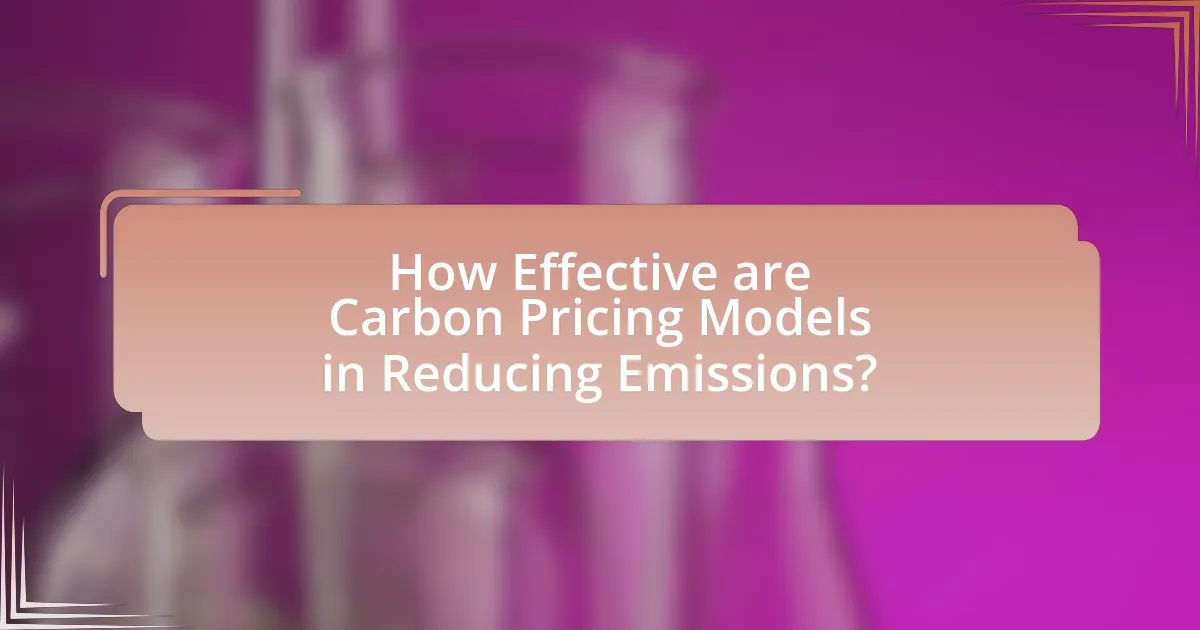Carbon pricing models are economic strategies aimed at reducing greenhouse gas emissions by assigning a cost to carbon emissions, thereby incentivizing lower carbon footprints among businesses and individuals. This article evaluates the effectiveness of various carbon pricing models globally, including carbon taxes and cap-and-trade systems, and examines their implementation across different economies. Key components, interactions, and challenges of these models are discussed, along with successful case studies from countries like Sweden and Canada. The article also explores the influence of international agreements, technological advancements, and public policy trends on the evolution and effectiveness of carbon pricing strategies in mitigating climate change.

What are Carbon Pricing Models and Why are They Important?
Carbon pricing models are economic strategies designed to reduce greenhouse gas emissions by assigning a cost to carbon emissions, thereby incentivizing businesses and individuals to lower their carbon footprint. These models are important because they create a financial mechanism that encourages the adoption of cleaner technologies and practices, ultimately contributing to climate change mitigation. For instance, the World Bank reported that as of 2021, over 60 carbon pricing initiatives were implemented globally, covering about 22% of global emissions, demonstrating their role in promoting sustainable economic growth while addressing environmental challenges.
How do Carbon Pricing Models function in different economies?
Carbon pricing models function by assigning a cost to carbon emissions, incentivizing reductions in greenhouse gas emissions across various economies. In developed economies, such as the European Union, carbon pricing often takes the form of cap-and-trade systems, where a limit is set on emissions and companies can buy and sell allowances, leading to market-driven reductions. For instance, the EU Emissions Trading System has successfully reduced emissions by approximately 35% since its inception in 2005.
In contrast, developing economies may implement carbon taxes, which directly charge a fee per ton of emitted CO2. Countries like Mexico have adopted this approach, generating revenue that can be reinvested in sustainable projects. The effectiveness of these models varies; for example, a study by the World Bank in 2021 indicated that carbon pricing could potentially reduce global emissions by 30% if widely adopted.
Additionally, the economic context influences the implementation and effectiveness of carbon pricing. Economies reliant on fossil fuels may face resistance due to potential impacts on energy prices and economic growth, while those with diversified energy sources may find it easier to adopt such models. Overall, the function of carbon pricing models is shaped by local economic conditions, regulatory frameworks, and public acceptance, leading to diverse outcomes in emission reductions globally.
What are the key components of Carbon Pricing Models?
The key components of Carbon Pricing Models include carbon taxes, cap-and-trade systems, and emissions trading schemes. Carbon taxes impose a direct fee on the carbon content of fossil fuels, incentivizing reductions in greenhouse gas emissions. Cap-and-trade systems set a limit on total emissions and allow companies to buy and sell allowances, creating a market for carbon credits. Emissions trading schemes facilitate the trading of these allowances, promoting cost-effective emission reductions. These components are essential for establishing a financial mechanism that encourages lower carbon emissions and supports climate change mitigation efforts.
How do these components interact to influence carbon emissions?
Carbon pricing models interact with economic activities, regulatory frameworks, and technological advancements to influence carbon emissions. Economic activities, such as production and consumption, are directly affected by carbon pricing, which incentivizes businesses to reduce emissions by incorporating the cost of carbon into their operations. Regulatory frameworks establish the rules and limits for emissions, guiding how carbon pricing is implemented and enforced. Technological advancements provide alternative solutions and innovations that can lower emissions, making it easier for businesses to comply with carbon pricing. For instance, a study by the World Bank in 2021 found that countries implementing carbon pricing saw a 2% reduction in emissions on average, demonstrating the effectiveness of these components in driving down carbon emissions.
What are the different types of Carbon Pricing Models?
The different types of carbon pricing models are carbon taxes and cap-and-trade systems. Carbon taxes impose a fee on the carbon content of fossil fuels, incentivizing reductions in greenhouse gas emissions by making carbon-intensive energy sources more expensive. For example, Sweden implemented a carbon tax in 1991, which has contributed to a significant decrease in emissions while maintaining economic growth. Cap-and-trade systems, on the other hand, set a limit on total emissions and allow companies to buy and sell allowances for emissions, creating a market for carbon credits. The European Union Emissions Trading System (EU ETS), established in 2005, is one of the largest cap-and-trade systems and has been effective in reducing emissions across member states. Both models aim to internalize the environmental costs of carbon emissions, promoting cleaner energy alternatives.
What distinguishes a carbon tax from a cap-and-trade system?
A carbon tax directly imposes a fee on the carbon content of fossil fuels, while a cap-and-trade system sets a limit on total greenhouse gas emissions and allows companies to buy and sell emission allowances. The carbon tax incentivizes reductions by making carbon emissions more expensive, whereas cap-and-trade creates a market for emissions, encouraging companies to innovate and reduce emissions to sell excess allowances. This distinction is crucial in understanding how each system aims to reduce carbon emissions and their respective economic impacts.
How do hybrid models combine elements of both carbon taxes and cap-and-trade?
Hybrid models combine elements of both carbon taxes and cap-and-trade by implementing a fixed price on carbon emissions while also establishing a cap on total emissions. This approach allows for predictable pricing through the tax component, which incentivizes emissions reductions, while the cap-and-trade element creates a market for emissions permits, enabling flexibility in how reductions are achieved. For instance, the European Union’s Emissions Trading System incorporates a price floor, akin to a carbon tax, ensuring that the cost of carbon does not fall below a certain level, thus providing stability and encouraging investment in low-carbon technologies. This dual mechanism aims to balance economic efficiency with environmental effectiveness, addressing the limitations inherent in using either system alone.
What are the global trends in Carbon Pricing Models?
Global trends in carbon pricing models include the increasing adoption of carbon taxes and cap-and-trade systems, with over 60 carbon pricing initiatives implemented worldwide as of 2023. Countries such as Sweden and Canada have established high carbon tax rates, exceeding $100 per ton, which have effectively reduced greenhouse gas emissions. Additionally, the European Union’s Emissions Trading System (EU ETS) remains the largest carbon market, influencing global pricing trends. The integration of carbon pricing into national policies is also rising, driven by commitments to the Paris Agreement and net-zero targets, with many nations aiming to align their economic strategies with climate goals.
Which countries have implemented successful Carbon Pricing Models?
Countries that have implemented successful carbon pricing models include Sweden, Canada, and the United Kingdom. Sweden has one of the highest carbon taxes globally, set at approximately $137 per ton of CO2, which has significantly reduced emissions since its introduction in 1991. Canada has adopted a federal carbon pricing system that mandates a minimum price on carbon emissions, which has led to a decrease in greenhouse gas emissions across various provinces. The United Kingdom’s carbon pricing mechanism, which includes a carbon floor price, has contributed to a substantial reduction in coal use and overall emissions since its implementation. These examples demonstrate the effectiveness of carbon pricing in achieving environmental goals.
How have international agreements influenced the adoption of Carbon Pricing?
International agreements have significantly influenced the adoption of carbon pricing by establishing frameworks and commitments that encourage countries to implement such mechanisms. For instance, the Paris Agreement, adopted in 2015, set a global target to limit temperature rise, prompting nations to consider carbon pricing as a viable tool for reducing greenhouse gas emissions. Additionally, agreements like the Kyoto Protocol have historically incentivized countries to adopt emissions trading systems and carbon taxes, leading to the establishment of various regional and national carbon pricing initiatives. These agreements create a sense of accountability and urgency, driving governments to align their policies with international climate goals, thereby facilitating the broader acceptance and implementation of carbon pricing strategies.

How Effective are Carbon Pricing Models in Reducing Emissions?
Carbon pricing models are effective in reducing emissions, as evidenced by various studies showing significant decreases in greenhouse gas outputs. For instance, the World Bank reported that countries implementing carbon pricing mechanisms have seen emissions reductions of 2-3% annually. Additionally, a study by the International Monetary Fund found that carbon pricing can lead to a 20% reduction in emissions by 2030 if widely adopted. These models create financial incentives for businesses to lower their carbon footprint, thereby promoting cleaner technologies and practices.
What evidence exists to support the effectiveness of Carbon Pricing Models?
Carbon pricing models have demonstrated effectiveness in reducing greenhouse gas emissions, as evidenced by various studies and real-world implementations. For instance, a report by the World Bank in 2021 indicated that countries with carbon pricing mechanisms, such as Sweden and Canada, have successfully reduced their emissions by 25% and 15% respectively since the introduction of these policies. Additionally, research published in the journal “Nature” in 2020 found that carbon pricing can lead to a significant decrease in carbon intensity, with a 10% increase in carbon price correlating with a 2-3% reduction in emissions. These findings underscore the role of carbon pricing in incentivizing lower carbon emissions and promoting sustainable practices.
How do Carbon Pricing Models impact overall greenhouse gas emissions?
Carbon pricing models significantly reduce overall greenhouse gas emissions by creating a financial incentive for emitters to lower their carbon output. These models, such as carbon taxes and cap-and-trade systems, assign a cost to carbon emissions, encouraging businesses and individuals to adopt cleaner technologies and practices. For instance, a study by the World Bank in 2021 found that countries implementing carbon pricing saw an average reduction in emissions by 2-3% annually, demonstrating the effectiveness of these models in driving down greenhouse gas emissions.
What role do economic factors play in the effectiveness of these models?
Economic factors significantly influence the effectiveness of carbon pricing models by determining the financial incentives for reducing emissions. For instance, higher carbon prices can lead to increased investment in renewable energy and energy efficiency, as businesses seek to minimize costs associated with carbon emissions. A study by the World Bank in 2021 found that countries with robust carbon pricing mechanisms saw a 20% increase in clean energy investments compared to those without such measures. Additionally, economic conditions, such as GDP growth and energy prices, can affect the implementation and acceptance of these models, as seen in the European Union, where economic stability has facilitated the expansion of carbon markets.
What challenges do Carbon Pricing Models face in implementation?
Carbon pricing models face significant challenges in implementation, primarily due to political resistance, economic concerns, and administrative complexities. Political resistance often arises from stakeholders who fear economic repercussions, such as job losses in carbon-intensive industries. Economic concerns include the potential for increased costs to consumers and businesses, which can lead to public backlash. Administrative complexities involve the need for robust monitoring and enforcement mechanisms to ensure compliance, which can be resource-intensive and difficult to manage. For instance, a study by the World Bank in 2021 highlighted that only 22% of global greenhouse gas emissions were covered by carbon pricing, indicating widespread challenges in adoption and enforcement.
How do political and public perceptions affect the success of Carbon Pricing?
Political and public perceptions significantly influence the success of carbon pricing by shaping policy acceptance and implementation. When political leaders advocate for carbon pricing and align it with public values, such as environmental protection and economic fairness, it increases the likelihood of successful adoption. For instance, countries like Sweden and Canada have seen effective carbon pricing policies due to strong political support and public backing, which is evidenced by Sweden’s carbon tax leading to a 25% reduction in greenhouse gas emissions since its implementation in 1991. Conversely, negative public perceptions, often fueled by concerns over economic impacts or equity issues, can lead to political pushback and policy rollbacks, as seen in France, where public protests against fuel taxes resulted in the suspension of a planned carbon tax increase in 2018. Thus, the interplay between political advocacy and public sentiment is crucial for the effective implementation of carbon pricing initiatives.
What are the economic implications of implementing Carbon Pricing Models?
Implementing Carbon Pricing Models has significant economic implications, primarily influencing market behavior and investment patterns. By assigning a cost to carbon emissions, these models incentivize businesses to reduce their carbon footprint, leading to a shift towards cleaner technologies and renewable energy sources. For instance, countries like Sweden, which implemented a carbon tax in 1991, have seen a reduction in greenhouse gas emissions by 25% while maintaining economic growth, demonstrating that carbon pricing can drive environmental benefits without hindering economic performance. Additionally, carbon pricing can generate substantial government revenue, which can be reinvested in sustainable infrastructure or returned to citizens through rebates, further stimulating economic activity.
What lessons can be learned from existing Carbon Pricing Models?
Existing carbon pricing models demonstrate that effective implementation requires clear regulatory frameworks and stakeholder engagement. For instance, the European Union Emissions Trading System (EU ETS) has shown that a well-defined cap-and-trade system can lead to significant emissions reductions, achieving a 35% decrease in emissions from 2005 to 2019. Additionally, models like British Columbia’s carbon tax illustrate that predictable pricing can incentivize businesses and consumers to adopt cleaner technologies, resulting in a 5-15% reduction in emissions while maintaining economic growth. These examples highlight the importance of transparency, adaptability, and integration with broader climate policies to enhance the effectiveness of carbon pricing initiatives.
What best practices have emerged from successful implementations?
Best practices that have emerged from successful implementations of carbon pricing models include establishing clear price signals, ensuring stakeholder engagement, and integrating revenue recycling mechanisms. Clear price signals incentivize emissions reductions by providing a predictable cost for carbon emissions, which has been shown to drive innovation and investment in low-carbon technologies. Stakeholder engagement, including consultations with businesses, environmental groups, and the public, fosters broader acceptance and compliance, as evidenced by successful programs in countries like Sweden and Canada. Additionally, integrating revenue recycling mechanisms, such as investing in renewable energy or providing rebates to households, enhances public support and mitigates potential economic burdens, as demonstrated by the positive outcomes in British Columbia’s carbon tax model.
How can failures inform future Carbon Pricing strategies?
Failures in carbon pricing strategies can provide critical insights for future implementations by highlighting inefficiencies and areas for improvement. For instance, the European Union Emissions Trading System (EU ETS) faced challenges such as over-allocation of permits, which led to a significant drop in carbon prices and reduced incentives for emission reductions. Analyzing these failures allows policymakers to adjust permit allocation methods and implement stricter caps to enhance market stability. Furthermore, the failure of certain carbon taxes to achieve desired emissions reductions, as seen in British Columbia, underscores the importance of integrating complementary policies, such as renewable energy incentives, to bolster effectiveness. By learning from these specific instances, future carbon pricing strategies can be designed to avoid past mistakes, ensuring more robust and effective frameworks for reducing greenhouse gas emissions.

What Future Developments Can We Expect in Carbon Pricing Models?
Future developments in carbon pricing models are expected to include increased integration of technology for real-time monitoring and reporting, enhanced flexibility in pricing mechanisms, and broader international cooperation. Technological advancements, such as blockchain and AI, will facilitate more accurate emissions tracking and improve transparency, as evidenced by pilot projects in various countries. Additionally, carbon pricing frameworks are likely to evolve towards hybrid models that combine carbon taxes with cap-and-trade systems, allowing for more adaptive responses to market conditions. International agreements, like the Paris Agreement, are pushing nations to align their carbon pricing strategies, promoting a more unified global approach to emissions reduction.
How might technological advancements influence Carbon Pricing Models?
Technological advancements can significantly enhance the accuracy and efficiency of carbon pricing models by enabling better data collection, analysis, and forecasting. For instance, innovations in satellite technology and IoT devices allow for real-time monitoring of emissions, which can lead to more precise assessments of carbon footprints across various sectors. According to a study by the International Energy Agency, improved data analytics can increase the effectiveness of carbon pricing by up to 30%, as it allows for more informed policy decisions and adjustments to pricing mechanisms based on actual emissions data. Furthermore, advancements in machine learning can optimize carbon market operations, facilitating dynamic pricing that reflects real-time supply and demand conditions.
What role does innovation play in enhancing the effectiveness of these models?
Innovation significantly enhances the effectiveness of carbon pricing models by introducing advanced technologies and methodologies that improve data accuracy and predictive capabilities. For instance, innovations such as satellite monitoring and blockchain technology enable more precise tracking of emissions and transactions, thereby increasing transparency and accountability in carbon markets. Additionally, the development of dynamic pricing algorithms allows for real-time adjustments based on market conditions, which can lead to more efficient resource allocation. Research from the World Bank indicates that countries implementing innovative approaches in carbon pricing have seen up to a 30% increase in compliance rates, demonstrating the tangible benefits of integrating innovation into these models.
How can data analytics improve the design of Carbon Pricing Models?
Data analytics can enhance the design of Carbon Pricing Models by providing insights into emissions data, economic impacts, and behavioral responses. By analyzing historical emissions data, policymakers can identify trends and patterns that inform the pricing structure, ensuring it reflects actual environmental costs. For instance, a study by the World Bank found that data-driven models can optimize carbon pricing by adjusting rates based on sector-specific emissions profiles, leading to more effective reductions in greenhouse gas emissions. Additionally, predictive analytics can forecast the economic impact of different pricing scenarios, allowing for adjustments that minimize negative effects on industries while maximizing environmental benefits. This evidence-based approach ensures that Carbon Pricing Models are both efficient and equitable, ultimately improving their effectiveness in reducing carbon emissions globally.
What are the potential impacts of global climate policies on Carbon Pricing?
Global climate policies can significantly influence carbon pricing by establishing regulatory frameworks that either enhance or limit market mechanisms for carbon emissions. For instance, the implementation of international agreements like the Paris Agreement encourages countries to adopt carbon pricing strategies, which can lead to increased demand for carbon credits and higher prices. Additionally, policies that set stringent emissions reduction targets can create a more robust carbon market, driving up prices as companies seek to comply with regulations. Conversely, inconsistent or poorly designed policies may lead to market volatility and reduced effectiveness of carbon pricing, as seen in regions with fluctuating carbon prices due to regulatory uncertainty.
How might future international agreements shape Carbon Pricing strategies?
Future international agreements may significantly influence carbon pricing strategies by establishing standardized frameworks and commitments among nations. These agreements can promote uniformity in carbon pricing mechanisms, encouraging countries to adopt similar pricing levels and methodologies, which can enhance market stability and predictability. For instance, the Paris Agreement aims to limit global warming, which may lead to countries implementing carbon pricing as a tool to meet their emissions reduction targets. Additionally, agreements that include financial incentives or penalties for carbon emissions can drive nations to adopt more aggressive carbon pricing strategies, as seen in the European Union’s Emissions Trading System, which has successfully reduced emissions through market-based pricing.
What trends in public policy could affect the evolution of Carbon Pricing Models?
Trends in public policy that could affect the evolution of Carbon Pricing Models include increasing regulatory frameworks, international climate agreements, and the integration of social equity considerations. Regulatory frameworks, such as the European Union’s Green Deal, aim to enhance carbon pricing mechanisms by setting stricter emissions targets, thereby incentivizing businesses to adopt cleaner technologies. International climate agreements, like the Paris Agreement, encourage countries to implement carbon pricing as a tool for achieving nationally determined contributions (NDCs), which can lead to more harmonized pricing strategies across borders. Additionally, the growing emphasis on social equity in climate policy is prompting governments to design carbon pricing models that consider the economic impacts on low-income populations, potentially leading to more progressive pricing structures. These trends collectively shape the future landscape of carbon pricing by promoting more comprehensive and inclusive approaches to emissions reduction.
What practical steps can stakeholders take to enhance Carbon Pricing effectiveness?
Stakeholders can enhance Carbon Pricing effectiveness by implementing transparent pricing mechanisms and ensuring robust regulatory frameworks. Transparent pricing allows businesses and consumers to understand the costs associated with carbon emissions, leading to more informed decision-making. For instance, countries like Sweden have successfully utilized a clear carbon tax structure, resulting in a significant reduction in greenhouse gas emissions by 25% since 1990 while maintaining economic growth. Additionally, stakeholders should engage in regular assessments of carbon pricing impacts, using data to adjust policies as needed, which has been shown to improve compliance and effectiveness in various jurisdictions.
How can businesses adapt to and benefit from Carbon Pricing Models?
Businesses can adapt to and benefit from Carbon Pricing Models by integrating carbon costs into their financial planning and operational strategies. By doing so, companies can identify areas for emissions reduction, leading to cost savings and enhanced competitiveness. For instance, a study by the World Bank indicates that firms that proactively engage with carbon pricing can reduce their carbon footprint by up to 30% while simultaneously improving their market position. Additionally, businesses can leverage carbon credits and invest in renewable energy projects, which not only comply with regulations but also create new revenue streams. This strategic alignment with carbon pricing not only mitigates financial risks associated with carbon emissions but also positions businesses as leaders in sustainability, appealing to environmentally conscious consumers and investors.
What strategies can governments employ to improve public acceptance of Carbon Pricing?
Governments can improve public acceptance of carbon pricing by implementing transparent communication strategies, ensuring revenue recycling, and engaging stakeholders in the policy-making process. Transparent communication helps clarify the purpose and benefits of carbon pricing, reducing misconceptions; for instance, studies show that clear messaging can increase public support by up to 20%. Revenue recycling, where funds generated from carbon pricing are returned to the public through rebates or investments in green projects, can enhance perceived fairness and mitigate financial burdens. Engaging stakeholders, including businesses and community groups, fosters a sense of ownership and collaboration, which has been shown to increase acceptance rates significantly, as evidenced by successful initiatives in countries like Sweden and Canada.


